The Bolyai-Gauss-Lobachevski conference on
Non-Euclidean Geometry
and its Applications to Physics
A report on the scientific content of the conference may be read at
Bolyai-Gauss-Lobachevski
Hungary July 7-21, 1999
New York, Nyerigyháza, Debrecen, Budapest
The Debrecen Zoo has installed, between the pens for camels and kangaroos, a monument to the extinct species.
Bolyai-Gauss-Lobachevski
New York, Nyerigyháza, Debrecen, Budapest
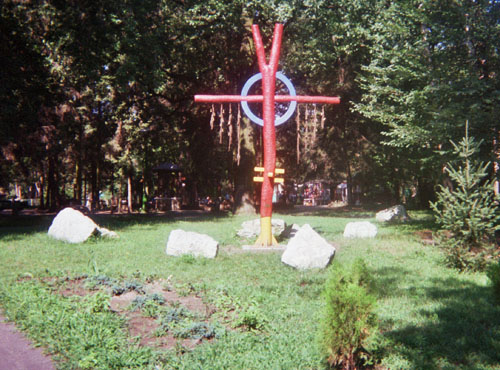
Red as burnished rubber, it rises erect, like a shorn tree trunk, or like a totem pole, an abstract Mondrianic grouping of crossbars. The largest and highest of these holds 8 pendant cords of bells that jangle in the breeze. Around the intersection of this crossbar with the trunk the sculptor has affixed a hazy blue halo: the religious overtones are obvious. At the very summit the trunk forks like a cloud-clutching divining rod.
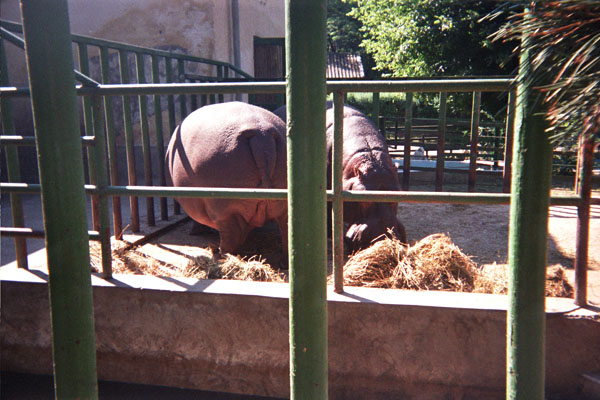
On the parched and patchy lawn about its base, painted a dull sock-yellow, lie half a dozen sculpted white stone blocks, coherently dispersed. The sculptor , Lázló Györí , explained to me , sitting in a classroom composed of Hungarian high school students from different parts of Eastern Europe, that the geometric shapes in these memorials are taken from a computer-generated artist's alphabet depicting the sounds of the Hungarian language .
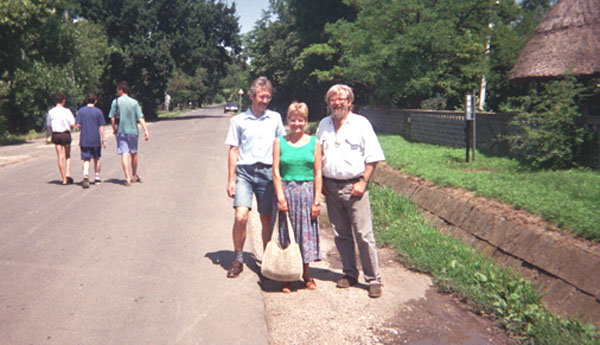
Sándor, Eva, Lázló
His memorials , which are to be found in many of Hungary's zoos, can therefore be read as well as watched.
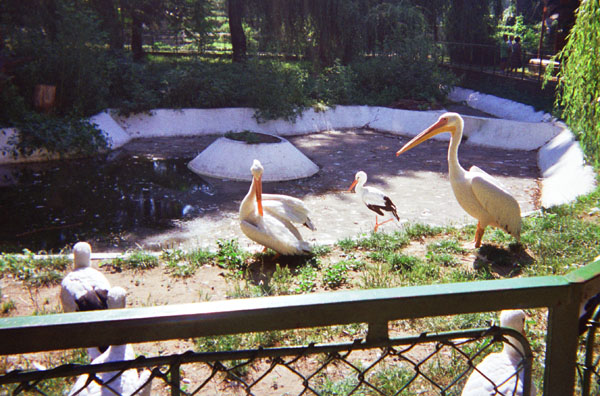
The street, Poroslay Ut, purls with beads of light reflected off the pools of water formed by the morning's rain. In the right lane stand a row of antique Soviet-style Moskva cars, vivid reminders of a half century of domination by the traditional enemy.
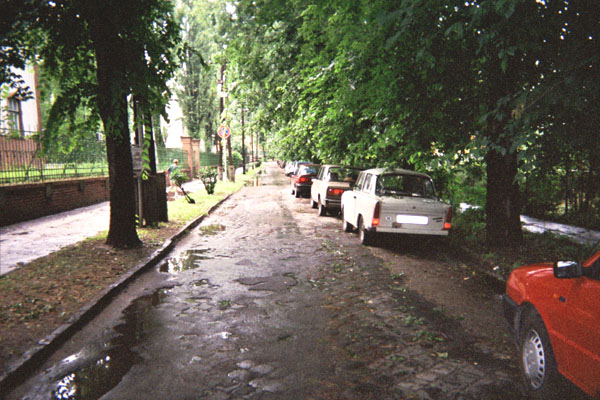 Many trees border this pleasant alleyway. On the left pavement one can see the gates and fences surrounding the courtyards of the Atomki, theoretical physics faculty of Debrecen University. and center for nuclear research. During my stay in Debrecen in an "academic's crash pad" lent me by one of its directors, István Lovas, I benefited greatly from the help of graduate students István and Ferenc, and departmental secretary Tunde.
Many trees border this pleasant alleyway. On the left pavement one can see the gates and fences surrounding the courtyards of the Atomki, theoretical physics faculty of Debrecen University. and center for nuclear research. During my stay in Debrecen in an "academic's crash pad" lent me by one of its directors, István Lovas, I benefited greatly from the help of graduate students István and Ferenc, and departmental secretary Tunde.
István speaks an excellent English: his graduate studies were done at the University of Chicago. In a few months, he said, he will be driving a car across the Northwest to take up a job at Lawrence Livermore Labs near San Francisco .
"Oh", I pounced, "So you'll be working for Edward Teller?"
István nodded and smiled, " Yes. Do you know Ed?"
" I don't know how to say this", ( the phrase having the usual implication of ' You don't know how much I enjoy saying this' ), " but Edward Teller is hated by millions of Americans ."
István chuckled; Ferenc laughed:
" Why do you say that?"
"Apart from his fanatic campaign for the H-bomb, ( which at least fulfills its mandate), he is also known as the father of the Strategic Defense Initiative ( Star Wars) , designed only to enrich himself by the promotion of fraudulent science."
" Aha ! So you think it's fraudulent?"
"Of course! The superlasers in particular are a joke. They've never worked, can't work, and are costing the taxpayers billions of dollars."
" Well, maybe Ed didn't know they wouldn't work when he proposed them ? "
"István, we all know that Edward Teller, however twisted his psyche, is a world class physicist. He's well aware the superlaser's nothing but a fantasy. "
We all laughed, and changed the subject.

At the right end of the dinner table. Bright pallid sunlight filing through muslin curtains casts high relief on the intimate features of the persons assembled at the far end of the dinner table: Djöndjy, secretary of the physics department at the Normal College at Nyiregyháza , gazes with pleased wonder in the direction of my camera. The lenses of her glasses are huge disks and, I suspect, very strong. I have caught all their startled faces by surprise.
The long white expanse of tablecloth is punctuated at regular intervals by bottles of medicinal Asvanvíz, Hungarian Vichy water, not as bad tasting as its French counterpart .
Next to her sits Tímea Tomosovsky, translator and guide, ( "dumpling" to me), student in Anglo-American studies at Debrecen University. A vixenish youngster in full command of her powers to charm, she wears a blue tee shirt. Her body weight leans on thin exposed lengths of forearm resting on the table.
Closer to my camera , Áttila Szokolny, physics graduate student and conference staff assistant, regards me with sardonic amusement. He's got a large head : weariness, sweat and a reddish cast are the evidences of the summer heat wave, so mild here in comparison to its New York City counterpart .
Áttila is thoughtful and prone to skepticism. A decade of freedom from Communism, he informs me, hasn't brought progress, only greater misery for everyone. In the region around Nyiregyhá za, unemployment stands at 30% . Formerly there were no homeless persons; now they fill the streets of Budapest. This speech, made for my benefit as one of the two American delegates breaks the ice. Now he explains that he's working for a degree in Statistical Mechanics and isn't interested in politics. His name, he says is "Áttila - like the Hooon ."
Áttila turns out to be one of the most helpful persons at the conference. On the second day he invited me to use the Internet from his office computer . Together with Tímea and myself , he made arrangements for me to stay on at the college hotel an extra two nights after the conference was over ; no easy matter, as we came up against an old style Communist-era bureaucrat who raised many pointless objections. ( I'll never forget how he held my key in his hand with a look that said: " I don't have to give this back to you, you know." )
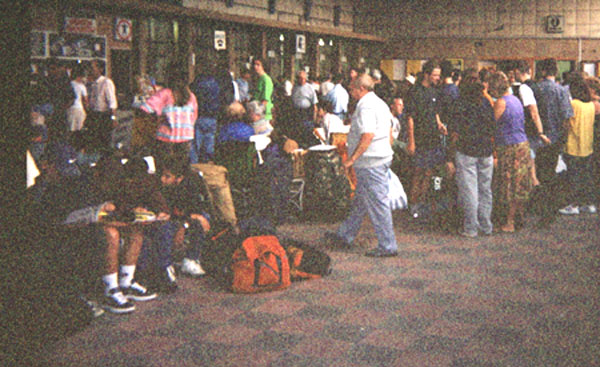
8 AM. Nyiregyháza's train station.
A lone long oblong block of a room. A few minutes ago the station was quiet as the quiet morgue in the idiom. Half-awake porters, office workers, street derelicts, slumbering on the benches. Snack bars and shops just beginning to open.
Now the first trains arrive from Budapest. Suddenly the station overflows with a hundred students carrying backpacks and camping gear, led by teachers, counselors , packmasters.
A refreshment stand, the "Both-Dega" ( bodega) is situated on the grounds at the eastern edge of Debrecen University, just to the right of the library, adjunct structure to the palatial and grandiose principal university faculty.
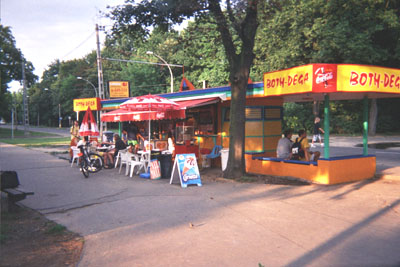
The Both-Dega sits beside the " University" stop of the Vilallamobus, Tramway #1 linking all parts of the city of Debrecen on a long vertical axis. A short walk further north brings one to the famous medical school, situated directly across from the Thermal Baths and their associated hotels.
Merely a glance at the stalls of the Both-Dega provokes a digestive upheaval : costly junk-food, plastic hamburgers, cheese snacks, candy . Yet a soda and a bag of chips can do no-one any harm. Take a rest in the shade of its gay beach umbrellas, then step across the tram tracks to enter a wonderland of public forests, sculpture -bedeckt promenades , restaurants, and a zoo filled with creatures from everywhere, all of whom speak perfect Hungarian!
The Both-Dega is thus a focal point for magic, a pedestal for stepping off to parks, zoos, universities, gardens, architecture, statuary, history and, of course, the tramway that connects up everything in this ancient and dynamic city. It has ever been said , that whatever Debrecen lacks in terms of natural defenses it has made up in spirit.
Anne-Marie had predicted some kind of ordeal and advised me to leave early . Shortly before noon we fastened little Benjamin ( age ~ 500 days) into a security chair hanging on the back of the driver's seat. She drove us from her Park Slope apartment (Brooklyn) to the subway entrance. Sitting in the back I pacified Benjamin with a bottle of warm tap water and Cheerios fed to him , one at a time, from the tip of my left index finger. Warily we edged our way around construction barriers. Anne-Marie wondered how men could work in such heat; no mystery to me, having played violin on street corners at even higher temperatures.
At Fulton Street we hit a pedestrian mall that wasn't supposed to be there, imposing a detour of 6 blocks. By the time we arrived at the Borough Hall-Jay Street subway entrance, it was 12:45 .
Anne-Marie hadn't exaggerated; verily the nightmare surpassed all of her projections. It had already taken us half an hour to drive to the subway stop. Then because of the murderous heat the A-train jogged , sluggishly and without pity, on half power . It had to be taken out of service at Rockaway station.
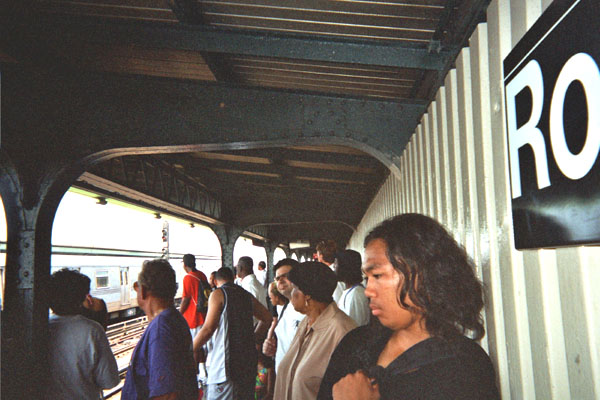 As the cars were being evacuated , a voice came over the loudspeaker announcing that a shuttle train would be materializing to carry us the rest of the way to Howard Beach, terminus for buses to JFK airport. That's where most of us were headed.
As the cars were being evacuated , a voice came over the loudspeaker announcing that a shuttle train would be materializing to carry us the rest of the way to Howard Beach, terminus for buses to JFK airport. That's where most of us were headed.
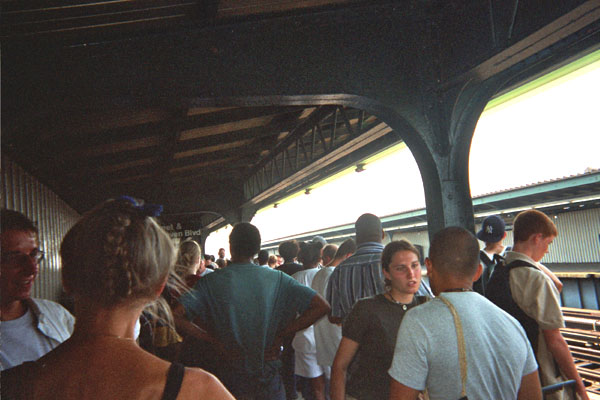
The shuttle never arrived. Anger, annoyance and worry streamed like gaily colored war banners across the agglomeration of over-heated countenances on the platform of the elevated station. So many people from so many places, all crowded together! A foretaste of foreign travel, right at home.
I entered the JFK airport at 3. The plane lifted off for Amsterdam and Budapest at 5.
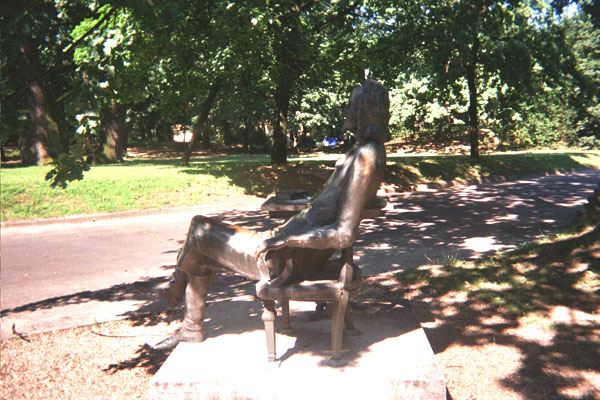 Hatvani István ! You cajole us across a distance of 3 centuries. There you sit, where Imre Varga has placed you in your metal chair on the Debrecen University campus. Under the spreading evergreens you are the happiest of Sphinxes. The corners of your eyes sparkle with eternal merriment.
Hatvani István ! You cajole us across a distance of 3 centuries. There you sit, where Imre Varga has placed you in your metal chair on the Debrecen University campus. Under the spreading evergreens you are the happiest of Sphinxes. The corners of your eyes sparkle with eternal merriment.You ( 1718-1786) have been called the "Hungarian Faust"; the "wise-aleck professor"; the " bearer of the Hungarian Enlightenment". You mix Leibniz, Franklin and Til Eulenspiegel in proportions not to be found anywhere else. Your mocking posture is mischievous, cynical. Your unalterable leisure poses a permanent question mark.
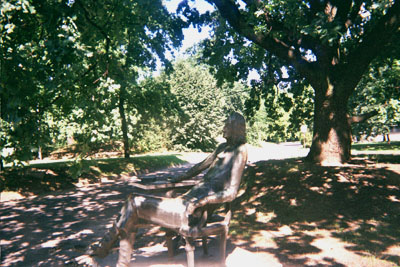 Hatvani István ! What would you say if you could return to us from the age of Voltaire and Rousseau, of Csokonai, Segner and Fazéhas, of Pope , Lessing, Beccaria? Would you not perhaps remark that the world remains much the same, alternating its patches of Enlightenment and Reaction , like the patches of light and shadow that play through the leaves , so gently yet so full of mischief, over your bronze immobility?
Hatvani István ! What would you say if you could return to us from the age of Voltaire and Rousseau, of Csokonai, Segner and Fazéhas, of Pope , Lessing, Beccaria? Would you not perhaps remark that the world remains much the same, alternating its patches of Enlightenment and Reaction , like the patches of light and shadow that play through the leaves , so gently yet so full of mischief, over your bronze immobility?
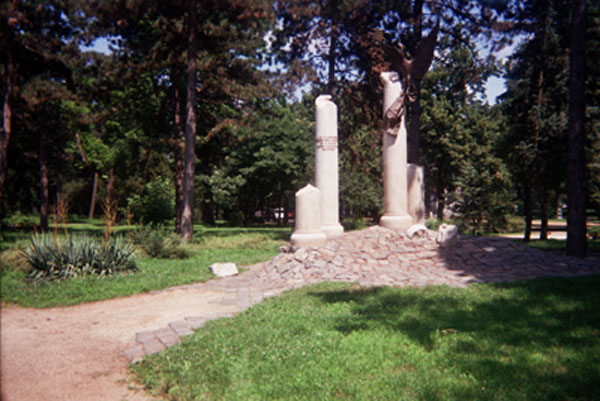 Hungary's war memorials did not impress us through their quantity, which we expected, nor their ubiquitous distribution, but through the nobility of conception . Such a one commands our attention near the entrance to Debrecen's Promenade of the Immortals , a walkway through stretches of public forest distinguished by many fine pieces of sculpture.
Hungary's war memorials did not impress us through their quantity, which we expected, nor their ubiquitous distribution, but through the nobility of conception . Such a one commands our attention near the entrance to Debrecen's Promenade of the Immortals , a walkway through stretches of public forest distinguished by many fine pieces of sculpture. The memorial comprises a group of 4 shattered pillars, two of them broken near their pedestals, all resting on the brick remains of a concrete bunker. On the crown of the tallest pillar, a black eagle rampant, rapacious and eviscerated. Its hideous power thunders in silence.
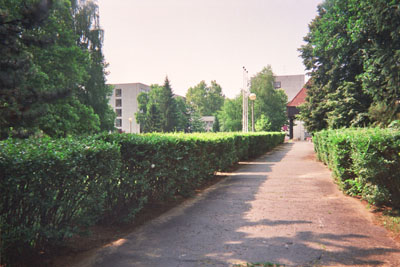
The Bolyai-Gauss-Lobachevski conference on Non-Euclidean Geometry and its Applications to Physics was held in the Gyorgy Bessenyei College of Higher Education in Nyiregyháza, Hungary, from July 7th to July 11th, 1999.
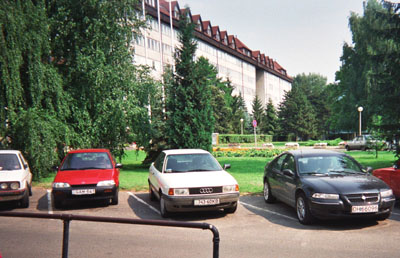
Most participants came from four Eastern European countries : Hungary, Romania, Russia and the Ukraine. As István Lovas (co-organizer , ( with Lázló Jenkovsky) , editor of High Energy Ion Physics , member of the Hungary Academy Sciences, professor in Theoretical Physics at Debrecen University, and writer of political articles for Budapest newspapers ) , told us, the purpose of the conference was to re-establish ties between scientific communities that had been severed by the Cold War.

The author may be identified by his tie!
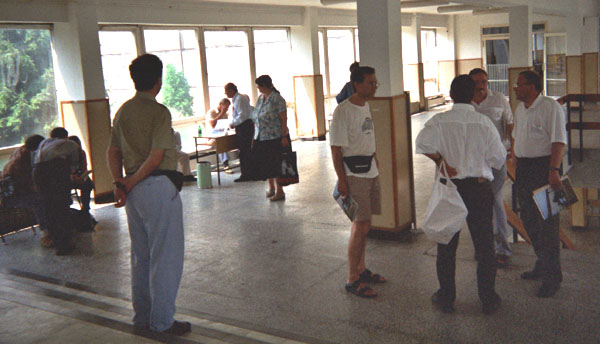 A handful of delegates came from elsewhere : Italy, Japan, France, England, the United States, Poland, Egypt, Norway . Norway's delegate was actually an immigrant from Hungary; and the other American, John Klauder , is married to a Hungarian.
A handful of delegates came from elsewhere : Italy, Japan, France, England, the United States, Poland, Egypt, Norway . Norway's delegate was actually an immigrant from Hungary; and the other American, John Klauder , is married to a Hungarian.
England was represented in the person of Jeanette Nelson, quantum gravitationist now living with her husband in Torino, Italy, sometime fellow at Princeton's Institute for Advanced Study.
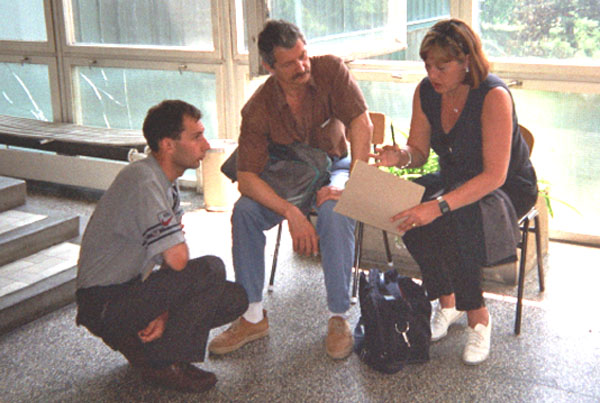
Jeanette Nelson with Colleagues
Jeanette and I uncovered many co-joining links, knots and braids: a shared interest in Knot Theory; a mutual friend in Lou Kauffman; the peculiar sense of humor peculiar to mathematicians; and all the advantages that a command of English can provide at a science conference where it's the official language but almost no-one speaks it with any fluency .
With some notable exceptions, most of the participants either spoke no English or ( which could be worse) spoke it badly. Accordingly, on Thursday July 8th, the first day of lectures, Lázló Jenkovsky, ( Hungarian from Romania who now directs a physics research institute in the Ukraine), stood alongside the speakers ( at the front of a mounting array of semi-circular desks and chairs ( washing up against the cylindrical containment tank of the auditorium like a tidal wave in remission)) , and did consecutive translation into English from eloquently and passionately spoken Hungarian, Russian, Ukrainian and Romanian! Jenkovsky also speaks French, Italian and German. It was significant that no Germans were present at a conference honoring the memory of Carl Friedrich Gauss : healing the wounds of the Cold War did not extend to those created by the previous war.
 For the remainder of the conference, participants were on their own. Thereafter , a typical lecture proceeded somewhat in the following fashion :
For the remainder of the conference, participants were on their own. Thereafter , a typical lecture proceeded somewhat in the following fashion :
The speaker avoids looking at the audience and stares stoically at a transparency illuminated by the lamp of a overhead projector. Synchronically he mumbles phrases that might perhaps be taken for English. The texts of the transparencies, ( crammed with equations interspersed by sentences of standard English that had been carefully prepared in the laboratory) are written with a very faint grey or red pencil, and unreadable at a distance of more than 3 feet.
It is not difficult to understand how Jeanette Nelson , John Klauder and I , speaking a "Queen's Quantum Gravity " jargon , took the conference by storm ! There were other competent speakers of Anglo-American , notably Jenkovsky and Lovas ; and the extroverted Alexander Yefremov, quaternionist and vice-rector of People's Friendship University in Moscow, with several years at the University of Texas at Austin in his record.
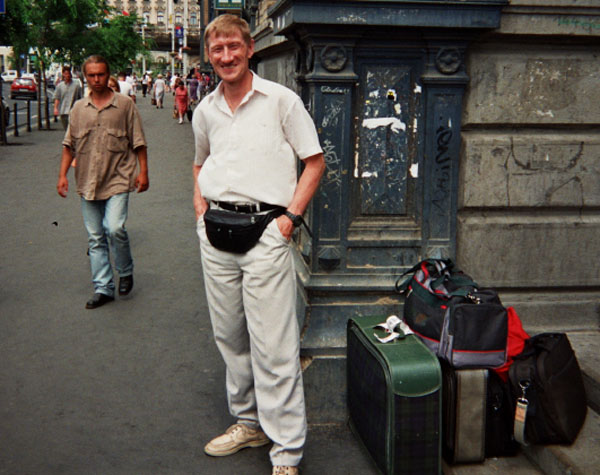
Alexander Yefremov
Jeanette's tone towards me was usually sarcastic. She expressed a desire to read Ferment's articles on Yugoslavia ( written in 1996), merely to have something of mine to systematically criticize. She professed to be shocked by the mere fact of my being an American ( as in "You Americans always ...." ) . And my anti-feminism was proven by the simple fact of my being a male. Taking her at her game, I relished inventing ways of evoking her horror. I precipitated a dead silence at dinner one evening, by announcing that Clinton and Yeltsin had just signed a trade agreement swapping whiskey for girls.
My own presentation at the conference can be accessed at Projective Constructs
The plane carrying me from Amsterdam to Budapest, KLM Flight 8374 , had assembled a cast of characters worthy of a Hitchcock movie . At the window on my left sat a girl, a Hungarian teen-ager . The businesswoman on my right was an American in her 30's. She wore thick make-up and squirmed inconsolably in a tight-fitting professional suit: jacket and short dress the color of yellow-pink fruit juice . Much of her time was occupied tearing up the pages of the business section of the International Wall Street Journal. Otherwise, save for a brief conversation, she napped.
These activities did not symptomize insanity. I learned that she is the Eastern European manager of an international employment agency for executive and middle management personnel. She'd returned just that morning to Europe from Sydney, Australia. Her plans included working all through the day in Budapest, then catching the plane to Prague that evening . Crammed beside her on her seat were two big pocket books and a big leather portfolio. A bulky suitcase sat in the luggage rack above our heads and across the aisle. She explained that an additional , very large, suitcase was in the hold.
Directly behind us sat an elderly Hungarian speaking to a married couple from St. Louis. The couple were Unitarian missionaries en route to Transylvania. From eavesdropping I learned that Unitarianism's origins are in Transylvania in the 16th century. Now part of Romania, Transylvania is home to 3,000,000 Hungarians. ( The terms of the punitive Trianon treaty of 1920 placed 30% of Europe's Hungarians outside Hungary's borders .)
The elderly gentleman spoke English with a charmingly varnished vanishing-Habsburg accent . He suffered from a kidney condition and stank of urine. Now living in Kansas City, he'd been a candidate for the ministry at one time , ( of which faith remained unclear), but confessed himself disillusioned with all religion. Despite this for the next half hour they talked about church organs.
The conversation then shifted to Transylvania's poverty. On their last visit the couple had driven there in a rented car from Vienna. They'd been obliged to deposit $15,000 , the full price of the car, with the rental agency. Cars of that quality weren't to be found anywhere in Transylvania and the chances of its being stolen were correspondingly high. The elderly Hungarian responded with a Hungarian anti-Romanian ethnic joke:
How do you tell an honest Romanian?
He does what he promised to do when he took the bribe.
 Two hours later I was standing outside the Nyugati train station in Budapest, waiting to catch the 1:30 train to Nyiregyháza.
Two hours later I was standing outside the Nyugati train station in Budapest, waiting to catch the 1:30 train to Nyiregyháza.
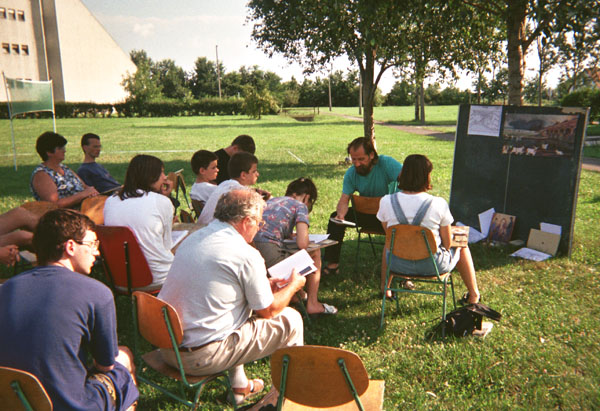
From the entrance to the Petöfi school, Sándor and I could hear a lecturing teacher's voice . The door to the room at the head of the staircase was blocked by a number of people, like us auditors to the class. Inside a path was opened for us, and I found myself facing a crowded classroom of about 30 students of high school age. The long monologue delivered by a short, dark-haired, middle-aged woman , turned out to be an introduction for the portly, tousle-headed man seated between a wooden table and the blackboard: Lázló Györí , sculptor .
3 incongruous stick figures were balanced on the table top . They resembled totem poles supporting cross-pieces with suggestively mystical shapes; one of them was crowned by a blue bird immobilized in flight. I couldn't understand a word spoken by either of them and concluded, ( incorrectly, but not by much ) , that these items were reconstructions of artifacts uncovered by archaeologists, accessories ancient altars employed in the religious rites of prehistoric Hungary. Lázló gave me a set of photographs of these installations , together with a computer printout of the glossary equating their geometric motifs to the sounds of the Hungarian language .
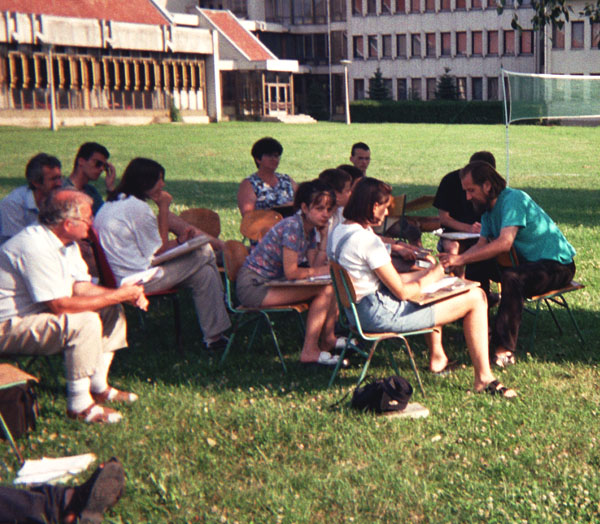
Thus was I introduced to the famous Petöfi Sándor Àltalános Iskola Art Academy in the Hortobágy national forest , dedicated to the reawakening of Hungarian national consciousness through art instruction for youth . Its summer camp attracts young people of Hungarian descent living in the greater Hungarian region covering parts of Serbia, Romania, the Ukraine, Slovakia and the Czech Republic. Their ages ranged from 12 to 18, and they behaved like typical European high school students, ( that is to say, like typical American high school students without the pistols and switch-blade knives ) : some were concentrated and silent, rapt with enthusiasm. Others took notes in a desultory fashion. Some were clearly bored. At the back of the class I noticed a few who'd fallen asleep.
By way of bringing the session to a close two sultry Romanian beauties, seated next to each other in the front row sang, ( in unison), a Hungarian folk song familiar to me from the many arrangements made of it by Bartok and Kodaly. Both had long dark reddish-brown hair, broad bosoms and flashing eyes. For a former composition student like myself, whose hearing has been permanently warped by Bartok's pentatonics and Schoenberg's dodecaphonics , the music had a refreshing familiarity.
The school's faculty , obviously pleased by the surprise appearance of a visitor from abroad, took me to lunch. It was a hot, sunny day; we walked into town in a group through narrow lanes bordered by yards filled with livestock: hens, roosters, ducks, pigs.
 On the way Lázló's sister, Eva , an attractive red-headed woman dressed in a sleeveless green pullover and faded flower print dress , carrying an enormous burlap shoulder bag, told me, in German, that the stick figures I'd seen were representatives of memorials - Denkmal - for the extinct species.
On the way Lázló's sister, Eva , an attractive red-headed woman dressed in a sleeveless green pullover and faded flower print dress , carrying an enormous burlap shoulder bag, told me, in German, that the stick figures I'd seen were representatives of memorials - Denkmal - for the extinct species.
 Many of them now stand in Hungary's zoos.
Many of them now stand in Hungary's zoos.
As we entered the dining room at the back of the inn , I remarked the friezes of paintings forming borders around the four walls. They turned out to be student and faculty work from the Petöfi school. In my amateur opinion much of it appeared to be very good indeed.Afterwards, returning to the school, we passed a few college age girls out on the streets selling so-called African jewelry and masks, of the sort one sees all over the world and is probably manufactured in a factory in Taiwan. Lázló walked by with contempt, I with disgust.
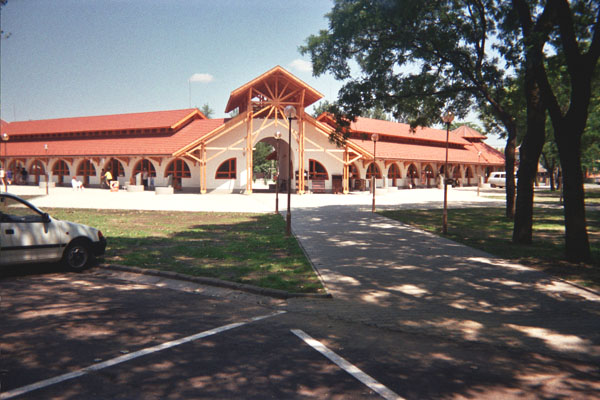
Reception Center, The Hortobágy
At one time the Hortobágy was the gateway to the Hungarian prairie, the Puzta, home to the legendary Hungarian cowboy. Now it appears to be turning into something of a dude ranch. However there are still many beautiful sights: old-fashioned restaurants and villas from the turn of the century; more war memorial sculptures; and the famous 9-arched bridge over the Tisza river.
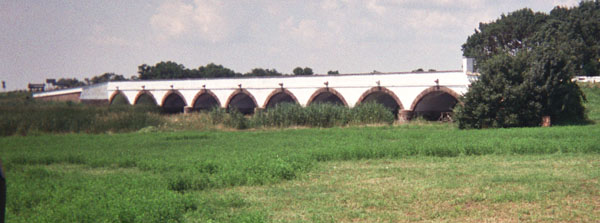
Bridge of the 9 Arches
Upon our return Lázló sold me a circular bronze pendant, cut with shapes based, as usual, on those of his symbolic language. Now I wear it frequently to remind me that I am destined, sooner or later, to join the extinct species.

The dreamer dreams. Maybe the dreamer also dreams that his death mask is staring at him as he dreams. He must not try to clarify his impressions, lest the effort will awaken him beforetimes.

The dreamer ( his head , ( hidden beneath the great lapel of his bronze raincoat) , might, at this distance, be taken for a bison's ) may also be staring at the death-mask jutting , ( like the head of a sardonic serpent ), from its tombstone slab . On this memorial sculpture on Debrecen's Promenade of the Immortals , who stares at whom? What stares at what? Which is the dream, which the dreamer, which is the dream of the dreamer? Answer: anything that has the greater claim to reality.
His hat has often been exposed to the rain. Water drips off the edges of its beaten metal , ( even when it isn't raining). Look how he puts his hands in his pockets ! A gangster, that much is certain. Pre- , or post-communist ? The political message may therefore be in the death-mask; or in the man who stares at it; or in both or neither. Or there may be no such message.
Great cleverness was needed at that time to get past the censors.
You absolutely must try the Döner Kebab while you're in Nyerigyháza. It's fantastic! Let me tell you about it :
I'm going to begin , (somewhat arbitrarily ) , with the conversation with Abner Sabry : he's the soft-spoken Egyptian who , whispering his labored English, lectured to us on geometry at the time of the Pharaohs.
Say ! What's that got to do with non-Euclidean geometry? What a question! It had to be non-Euclidean : Euclid wasn't born yet. Enough said....
On the Saturday night after the conference Sabry and I got to talking in the lounge of the college hotel . We exchanged business cards; he invited me to look him up on my next visit to Cairo. ( Parenthetically, Alexander Yefremov had urged me to put Egypt on my travel itinerary. According to him, the world's best scuba diving is to be had along its shores.)
Sabry mentioned in passing that he'd walked the two miles from the college to downtown Nyerigyháza in search of a good restaurant. He ended up in a place located on the western edge of the main plaza, directly across from the town's McDonald's . As in so much of the world , the Nyiregyháza McDonald's conveniently serves as origin of the local co-ordinate system: " You go to the McDonald's, turn right, then .... " . It's deserted emporia may well retain this function long after the last of them has closed its doors.
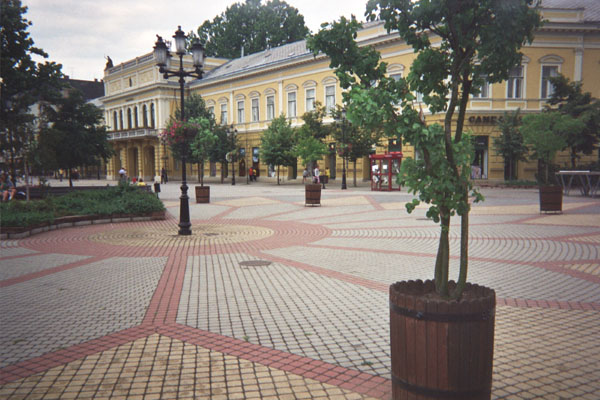 On the basis of Sabry's recommendation , I set off Sunday afternoon in search of this restaurant. The main plaza in Nyerigyháza is elegant and large; upon it the McDonald's sticks out prominently like a hypertrophied wart, its windows covered with posters advertising the latest innovation: some kind of meat product shaped like a hamburger and fresh as a sex-crazed politician: the McFresh . I needed great presence of mind to resist the urge to rush into the restaurant and demand my pound of McFlesh ! The sarcasm would have been wasted: the typical Hungarian's command of English is poor. And although Hungary has always been renowned for its theater, and all educated Hungarians know their Shakespeare, its reputation for anti-Semitism is not a good one.
On the basis of Sabry's recommendation , I set off Sunday afternoon in search of this restaurant. The main plaza in Nyerigyháza is elegant and large; upon it the McDonald's sticks out prominently like a hypertrophied wart, its windows covered with posters advertising the latest innovation: some kind of meat product shaped like a hamburger and fresh as a sex-crazed politician: the McFresh . I needed great presence of mind to resist the urge to rush into the restaurant and demand my pound of McFlesh ! The sarcasm would have been wasted: the typical Hungarian's command of English is poor. And although Hungary has always been renowned for its theater, and all educated Hungarians know their Shakespeare, its reputation for anti-Semitism is not a good one.
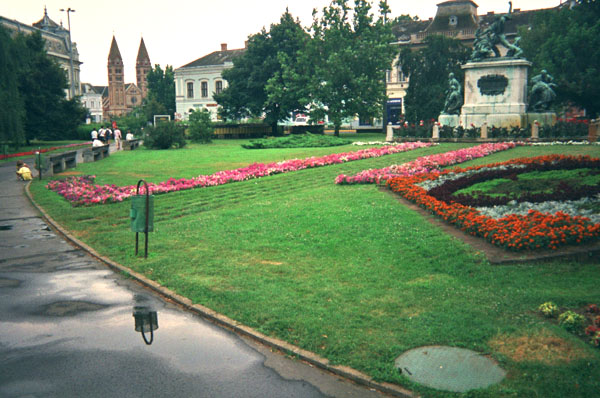 Directly across the colorful tapestry ( black, grey and red), laid down by a weave of flattened cobblestones coursing the grand plaza like a lava floe , stood the restaurant which Sabry had indicated .I went in to investigate . I learned that lunch wasn't being served for another half hour. I promised to return but knew that I wouldn't. The decor was flashy , indicating that food would be ordinary but expensive . The officially designated 'English-language' waiter was every bit as rude as his colleagues. In departing I identified only one really friendly face in the entire establishment: that of the cleaning lady .
Directly across the colorful tapestry ( black, grey and red), laid down by a weave of flattened cobblestones coursing the grand plaza like a lava floe , stood the restaurant which Sabry had indicated .I went in to investigate . I learned that lunch wasn't being served for another half hour. I promised to return but knew that I wouldn't. The decor was flashy , indicating that food would be ordinary but expensive . The officially designated 'English-language' waiter was every bit as rude as his colleagues. In departing I identified only one really friendly face in the entire establishment: that of the cleaning lady .
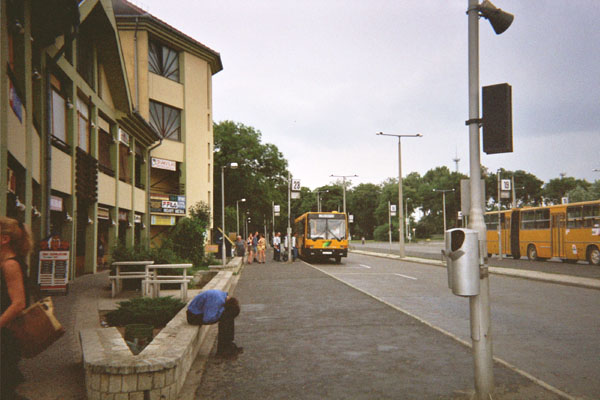 Thus I continued on, to the bus station, a place where, in France at least, one often finds a few acceptable restaurants . There may have been some but I couldn't find them. With reluctance I started back towards the one I'd just left.
Thus I continued on, to the bus station, a place where, in France at least, one often finds a few acceptable restaurants . There may have been some but I couldn't find them. With reluctance I started back towards the one I'd just left.
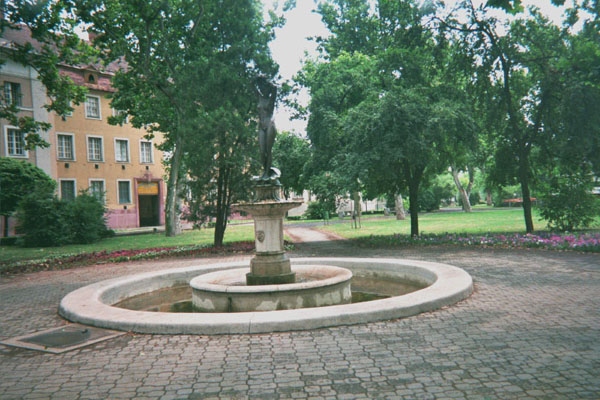
The route to and from the train station passes through wide abandoned streets holding monumental government buildings from the ever- echoing imperial past.
A rectangular niche surrounded by white-wash, cut into the solid stone. Doorway and window-frames painted a bright red . Marine blue panels bordering the base of the storefront.
- Russet awnings, a handful of plastic tables tilting like seasick sailors on a ratty patch of grass at the sidewalk's edge . Large cutouts of gold letters that obscure most of the picture window:
PASA GYROS
DöNER KEBAB
- Muffins and rolls piled up in a green box underneath the white frame of a Dutch window and its sliding panel used for unloading platters between kitchen and street.
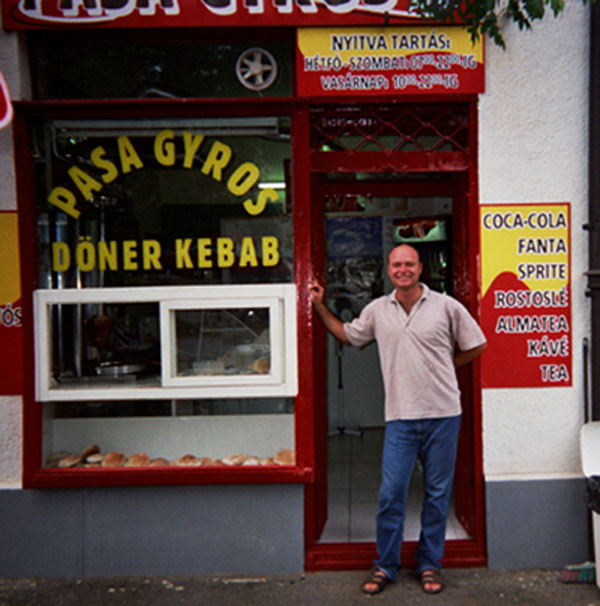
"If the rest of my fortunes turn Turk with me! " I cried. The jolly chef did indeed hail from Turkey. He'd ended up in Nyerigyháza via New York City and other privileged way-stations. Tall, blue jeans, pale gray tee shirt, razed pate. The short order café was empty save for its lone employee. I gathered that there was at least one brother helping him out during the long hours posted on the glass of the opened door : 7 AM to 10 PM .
The selection of items was limited: döner kebab put together from slabs of meat taken out of the freezer and heated in the microwave; gyros sandwiches pre-packaged in cellophane ; halvah , baklava ; and the ubiquitous standards: hamburgers, hot-dogs, factory -wrapped pies; Coca-Cola, Fanta, Sprite, coffee, tea, etc...Hardly haute cuisine , yet the friendliness of the owner-manager- waiter - cook imparted an atmosphere of luxury . Truly I was served as if I were a guest in his own home: a sandwich of döner kebab , a piece of baklava. I asked him if he carried Turkish tea. Ever-obliging, he produced a cellular telephone from his shirt pocket and called his brother. Alas, he'd already left home. I settled for two paper cups of Lipton tea sucked up in a straw.
Before my departure each of us took a picture of the other. There he is, standing against the bright July sunlight, leaning his weight onto the right palm pressed against the door frame, frank, cheery, unruffled, a one-man multi-national corporation on temporary stop-over in Nyerigyháza before taken flight, once more , to regions unknown.
 Drifting through the interior of the Boeing 747 the gloom descends, like summer rain, in sheets; closing my eyes merely increases the gloom. Not being sleepy I open them again, turning my gaze to staff, passengers, furnishings and accessories of KLM Flight 8641, aloft from New York to Amsterdam .
Drifting through the interior of the Boeing 747 the gloom descends, like summer rain, in sheets; closing my eyes merely increases the gloom. Not being sleepy I open them again, turning my gaze to staff, passengers, furnishings and accessories of KLM Flight 8641, aloft from New York to Amsterdam .At my left sits a woman absorbed in her book: a history of the Swedish peoples. I learn that she is en route to Sweden to join her husband, an air force officer. Tumbling across her lap the sunlight enters through a porthole from which are visible vistas of invisible fields, hillocks and valleys holding multitudes of caravans of muttonhead clouds. Like them, the plane, its inhabitants and cargo are afloat on cushions of air miles above the earth, beneficiaries of the elements and the elemental laws, ( notably Navier-Stokes and Kurtweg-DeVries ) , that neither care for us nor wish us any harm.
Destination: Budapest. Yet how can it be known in advance if, once arrived at Amsterdam, I will not choose , on a whim, to march out to the roads, bound for Paris, Rome, Hamburg, Vienna, Stockholm? Why not Vladivostok - or Beijing ? Indeed , there is delight in imagining such possibilities, but the truth of the matter is that I am a creature of itineraries; which does not mean that it is known in advance, know where I will end up. First Amsterdam, then Budapest and Nyerigyháza , to be sure. Yet afterwards ?
Wherever the road ends I will be sure to settle in for awhile . In this respect I am most decidedly non -American. Americans rarely travel: they consume. Watch them as they race through museums, hopping from painting to painting , wolfing down their ART. Or at restaurants, packing food down their esophagi , afraid of its potentially unsettling taste . ( Given the national cuisine, it is hard to blame us.) Not I: after the conference no more than one place will be visited , with possible side trips; no more . Nor will it be Budapest - the time is so short! 10 days may be just enough time to learn how to manage its subway system. Why slough through mud when one can navigate a clear stream?
Caramelized blue sky. Farm houses, sturdy and stuccoed, with rude frames and narrow windows. Slanting rooves tiled with overlapping rows of red clay brick. Straight fences, lines of regimented metal stakes , freshly painted, vine covered, supporting lush vegetation on both sides. Families of storks everywhere, on all the chimney pots and telephone poles, groomed, alert, ready to receive visitors.
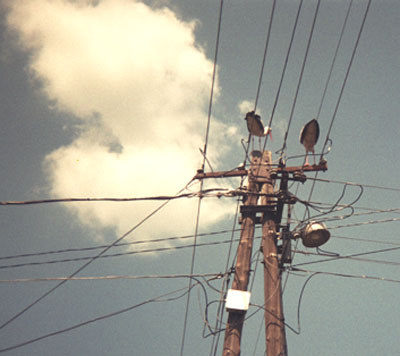
Storks had build their nests at the crest of every telephone pole and chimney pot . Family groups of 3 or 4 watched our passage with a bored indifference. Some may have been hooking up with their modems ; we observed them beating out messages with their beaks on the telephone wires. The Hortobágy is the stork capital of Hungary; it may well contain more storks than people.
Hungary's city buses, trolleys and trams operate on an unenforceable honor system. This system may have evolved under communism, yet seems to work just as well ( or badly) under capitalism. It is not that , by and large, people aren't honorable. It just happens to be a fact that almost no one on the planet feels that ripping off the government is a crime. It's our money , after all! And look at what they do with the remainder !
Before climbing aboard one of these vessels you must buy a ticket, nothing more than a rectangular paper slip, at a booth or official bus depot. Once inside you are supposed to insert the slip into an archaic device , a clumsy iron boot that punches a pattern of 3 holes . Yet before doing this several options are available. You can dutifully buy a new ticket for each bus trip. It seems that only foreigners do so. When I walked over to the machines to get my ticket punched, all eyes followed me with misgiving. I wondered if they thought of as an inspector in disguise.
Or you can guard the ticket, unpunched, from one bus to the next, keeping a look-out for inspectors. When you spot one you can jump up and punch it just before he reaches you . Or you can punch the ticket in your first bus , then hold onto it for the rest of the day. I was unable to notice, over a single day, any differences between the pattern of holes from one bus to the next .
And in fact I never saw an inspector. My impression is that passengers never punch tickets when they get on unless they think the conductor is looking at them. Then the entire population of the bus rushes to get its tickets punched.
Under Socialism one survives by cheating the system. Under Capitalism, cheating is the system. Over the term of my short visit I could not determine the nature of the economic theory in operation .
Meditations inspired by a half hour's delay , crushed flat against the breast of a broiling heat wave, at the elevated platform of Rockaway Station in Queens.
Crises and accidents are generally experienced as disappointments; all the same, nothing is more disappointing than an adventure without crises and accidents . The time invested in deciding whether or not this particular incident should have been classified among the adventures or the disappointments probably exceeded the half-hour spent waiting for the shuttle train that never arrived.
Faces around the platform are grim, sour, angry; although most New York residents look that way most of the time. My sense of duty tells me that I need to do lots of smiling to keep up the spirits of the others. Yet soon I , too, succumb to the general malaise.
A train pulls up and stops before the opposing platform, ,on the other side of the tracks . Should we signal for help? Have its conductors been informed of our distress? Does the anonymous Transit Authority intend to keep us standing here all afternoon? Have we been abandoned to the universe?
A train on our side comes to a halt just before entering the station. It sits there for quite some time , worn down, like ourselves , by the heat. Slowly it begins to move. Hopes revive, and expectations, and anticipations. Without a pause the train continues on until the last car has exited. Suddenly it stops. And once again it sits, immobilized. Perhaps they've received the message that we're stranded! Ten minutes pass, and the train moves away .
Surrounding me are college students; tourists ; businessmen; Jamaicans; Africans; French . Their features register dismay; anxiety; heat prostration ; impatience ; fatigue. Some of them must hail from countries where machines, people and the social order are breaking down all the time. Here this phenomenon is generally limited to in outlying rural districts.
One of the scheduled trains arrives, stops. Negotiations are initiated. The train makes a detour to bring us to our destinations. There will be not shuttle. All aboard. Soon we are on our way.
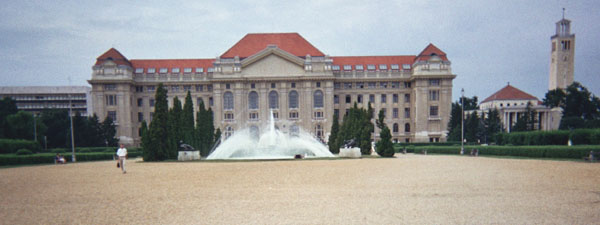
Debrecen University
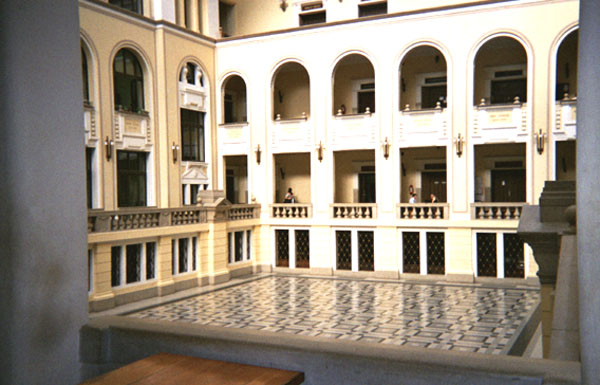
The corridors of the mezzanine gravitate around an interior courtyard.
Against its walls in regular progression stand high wooden doors , entrances to various academic departments:
Biochemistry, Anglo-American Studies, Business, Political Science. At the edge of the inner ring, the balcony the meter-long stone banisters are supported by dowel-like pillars in groups of five.

The corridors of the mezzanine gravitate around an interior courtyard. Against its walls in regular progression stand high wooden doors , entrances to various academic departments: Biochemistry, Anglo-American Studies, Business, Political Science. At the edge of the inner ring, the balcony the meter-long stone banisters are supported by dowel-like pillars in groups of five.
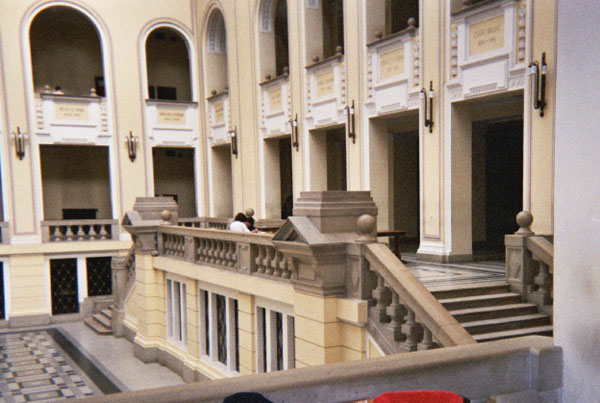
Great open cavities reach above these, rising three floors to terminate in grand circular arches. Persons sitting at tables
can peer down to the terrace and across its tiled parquet floor , stretched flat like a carpet inlaid with precious stones. As with all superior works of art this building
(built, amazingly, in the early 30's), derives its power from simple arrangements of fundamental elements, suggesting hierarchic levels of complexity which, though more apparent than real, are neither ponderous nor deceiving.
The inner courtyard is a quadrangle, garlanded with stone bands of decorative ornament, window-like openings, and graceful arches. A translucent skylight surmounts the field of the parquet floor . Through these grandiose vistas shines a powerful influx of light , neither dazzling nor brazen, spiritual in tone, perfect for reading, writing and other scholastic activities. Counting the arches leads one to the conclusion that the quadrangle is a perfect square. Via a palatial balustrade, combining a peristyle with adjacent ranges of marble steps descending downwards , regally like a wedding procession , one enters onto the inlaid white , black and grey tiles of the terrace.
At the base of each range of windows are inscribed the names, and administrative dates , of all the rectors of Debrecen University . Conspicuously absent is that of the most eminent of all of them, Mihály Vitas Csokanai ( 1753-1805) , kicked out of office for the crime of having too much imagination.
The color scheme is uniform and simple: tan, terra-cotta, ochre, marble. Ornamentation and iconography are so thickly applied that, gripped with fear, one briefly imagines oneself trapped within the covers of a book!
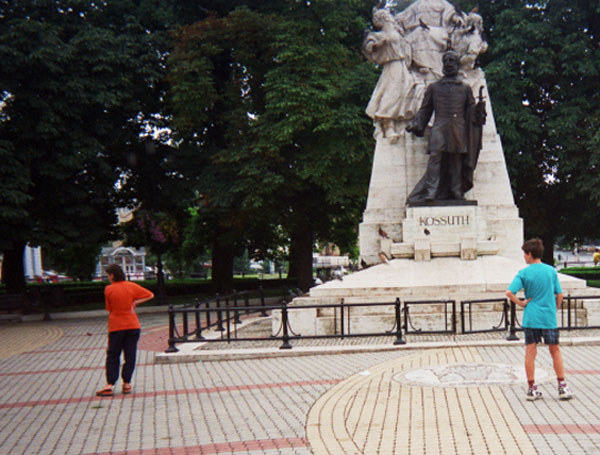 The grand plaza at Nyiregyháza. Broad parks surrounded by monumental government buildings, relics of too many pasts: Russian, German, Austrian, Turkish. The inevitable monuments to Lajos Kossuth and Sándor Petöfi: Kossuth is to George Washington as Petöfi is to Walt Whitman - as is Bela Bartok to Charles Ives, etc. Nationalism, the vaunting of unique claims to identity for a specific people, is ever most unoriginal in its defining categories .
The grand plaza at Nyiregyháza. Broad parks surrounded by monumental government buildings, relics of too many pasts: Russian, German, Austrian, Turkish. The inevitable monuments to Lajos Kossuth and Sándor Petöfi: Kossuth is to George Washington as Petöfi is to Walt Whitman - as is Bela Bartok to Charles Ives, etc. Nationalism, the vaunting of unique claims to identity for a specific people, is ever most unoriginal in its defining categories .
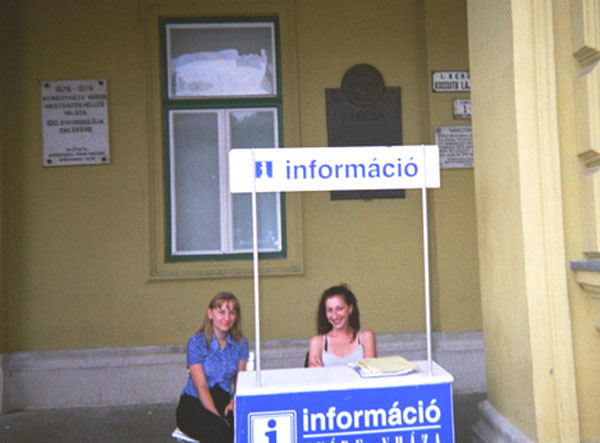 Two ladies, young and charming , sit in back of an information table, Információ , at the far end of the plaza. Their booth had been dragged beneath one of the towering archways of the theatrical Town Hall to protect them from the approaching rain. The archway is large; even the windows high up on the building at the back are huge. Monarchists , ( for this building could have only been constructed under a monarchy) , possess the particular gift for making a momentous display of virtually nothing. That's why so much splendid art is produced societies subject to great oppression.
Two ladies, young and charming , sit in back of an information table, Információ , at the far end of the plaza. Their booth had been dragged beneath one of the towering archways of the theatrical Town Hall to protect them from the approaching rain. The archway is large; even the windows high up on the building at the back are huge. Monarchists , ( for this building could have only been constructed under a monarchy) , possess the particular gift for making a momentous display of virtually nothing. That's why so much splendid art is produced societies subject to great oppression.
The girls are alert, ever eager to help. The one on the left speaks no English. Her companion, seated directly behind the information booth, has an English vocabulary of perhaps 20 words, enough to direct me to the train station. A friendly, hospitable people, these Hungarian. But they will not learn anyone else's language!
TÁLTOS ( pronounced "tartosh") : shaman, horse, bull, color, weather, time. Under the right conditions , any animal or human can embody the spirit of the táltos . From the gargantuan cosmic struggle of táltos bulls arise powerful storms. The dark bull fights the fair; there is a loose identification with 'good' and 'evil', though this characterization is over-simplified.
In its original signification, that of the celestial horse, its function is to transport heroes , the ancient Hungarian equivalents to Hercules, Gilgamesh, Siegfried, etc . , to the sites of those magnificent deeds that vaunt their illustrious names to mankind and the gods .
These are the things which the hero must do to obtain his táltos : by the authority of the ancient legends, the horse lies buried many leagues beneath the ground . Its locus is marked by a huge mound of dung . In a manner reminiscent of Hercules' cleansing of the Augean stables, the hero labors for eons to dig out the horse and haul it to the surface. In this form the táltos is still inert, shows no sign of life.
The hero must then run many miles, carrying it piggy-back , to a mythical spring of magical waters, crystalline and pure . The horse will not come back to life until it is thoroughly cleansed in this spring. Then it must be fed with a kind of divine manna, resembling red-hot living embers of coal.
Now at last, and only now, does it truly become a táltos . Riding on its back, the hero flies through the air, like Bellerophon upon Pegasus, as swift as the winds, as lightning, as thought.
There are many human embodiments, or avatars, of the táltos . It can be a man or woman with a divine vocation. It can also be a wandering scholar: in this incarnation it enters a village to request a bowl of milk. If the request is denied it quickly departs. Soon afterwards a hailstorm descends, wiping out half the village.
A cowherd may be a táltos. Asleep in a field, or in trance , a shepherd may dream the táltos into existence. Many of these personifications, metaphorical associations , symbolisms and transformations are present in the paintings of the great Hungarian painter Koszta Csontváry (1853-1919 ) , notably in "Storm on the Hortobágy ", on display in the Csontváry Museum in Pécs . Quote :
"This painting is typical of Csontváry in that it captures an ethereal and poetic moment which the artist deemed worthy of preservation" - James Bickford-Smith
Photo images of this and other paintings of his, as well as information about Csontváry's life and work, may be accessed at: Csontváry
Following the conference I was the guest of the Atomki, the nuclear research institute at Debrecen University. It came about this way: On the morning of Saturday, July 10th, after the final lecture , the entire delegation went back to the college hotel and conference center for lunch. Each of the tables in the dining-room held four place settings; I found myself seated to the right of István Lovas, professor of theoretical physics at Debrecen University , from the evidence one of Hungary's most distinguished scientists. Middle-aged, short and strongly built, his silvered moustache and hair convey enough of the Einstein aura to function as status symbols for his profession.
He'd read with great interest Ferment's background articles on Yugoslavia published in 1995. My discovery that the Moslems of Bosnia are the descendants of the Bogomil Christians of the 11th century, precursors to the Cathar and Albigensian dissidents of medieval France, intrigued him . He himself writes political articles for a Budapest newspaper. This led naturally into a discussion of the fundamental problem of Eastern European stability: as a result of endless terrible wars, all of its territories harbor populations uprooted from their own nations. To this we own the decade of civil wars in the Balkans; the dispersal of Hungarians across much of Central Europe; and the present plight of the ethnic Russians of Latvia, Lithuania and Estonia, unwelcome in their lands of birth and in the homelands of their ancestors .
Lovas asked me where I intended to go next : I said that I wanted to remain in Nyerigyháza another two days. Then I hoped to spend a bit of time in Debrecen, the nearest major city. In a little while he passed me one of his calling cards, printed in English. On the back of it he'd written down instructions for getting to the Atomki . A call to his departmental secretary would be placed that afternoon, explaining to her that I was to be given the key to his flat on the university grounds . I was welcome to use it for the rest of the summer.
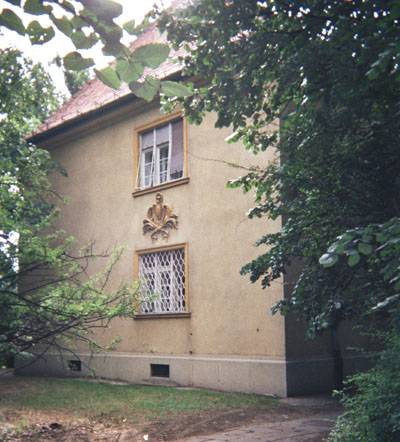 This generous offer grew out of a situation characteristic of the Hungarian context: many persons on the faculty at Debrecen University maintain their permanent residences in Budapest, Hungary's only large city . Lovas, together with two other faculty members, rents this flat for overnight stays during the school year. It's usually vacant in the summertime, when it can be made available to visiting scholars, or friends, and their families.
This generous offer grew out of a situation characteristic of the Hungarian context: many persons on the faculty at Debrecen University maintain their permanent residences in Budapest, Hungary's only large city . Lovas, together with two other faculty members, rents this flat for overnight stays during the school year. It's usually vacant in the summertime, when it can be made available to visiting scholars, or friends, and their families.
I left for Debrecen on Monday mid- morning. In theory a Dr. Arpad Szabo was delegated to meet me at the Debrecen train station, but the language barrier tangled the wires. I walked through all the rooms of the station at least three times without encountering anyone resembling a nuclear physicist. Szabo may well have been doing the same thing at the same time: a classic scenario of a two particle collision with small cross-section but vanishing probability, leading to the weaving of an ergodic , ( chaotic, erotic) , dance generated by two (approximately) infinite space-filling curves with contiguous boundaries, ( a famous construction in topology) .
After a fruitless attempt to use my Hungarian plastic telephone card I finally gave up. Since I knew where to go, more or less ( more less than more ) , I straggled out onto the street. There, ( after the interlude of confusion habitual to intellectuals who don't believe that there is a simple way to do anything ) , I bought myself a bus ticket and climbed onto Tram #1, the Vilallamobus . The efforts of the driver and two other helpful souls led to my being let off at the entrance to the Atomki. Then a woman going my way walked me around to the side of the building where, indeed, a security guard holding an envelope with keys had been expecting me for several hours .
As I waited he phoned the office of the graduate department to let them know I 'd arrived. In less than 10 minutes my guide appeared : Tünde Baljca . Tünde was young, a bit tired, unsophisticated, cute , red-haired, and friendly: all that a departmental secretary charged with delivering an American visitor to his residence over a mile away should be. She took one of my suitcases and together we walked the long distance to the stately faculties of the university along a dreary boulevard, the Egyetem Sugarût .
 On our arrival I invited her in for a glass of Tokaj wine . She regarded me with perplexity, until she finally figured out that I was pronouncing the "j" like a "dzh" , rather than a "y" . Before she left I took down her office number in case of emergencies. A cleaning woman arrived shortly afterwards. She quickly fixed up the 5 rooms of the flat, ( 3 bedrooms a kitchen and bathroom ) . Then she and I spent twenty minutes trying to figure out how to get the stove working. I never did master this craft, even after a week in the flat. By the time I left, I considered it an accomplishment that I could keep the gas flame going after lighting no more than 3 matches.
On our arrival I invited her in for a glass of Tokaj wine . She regarded me with perplexity, until she finally figured out that I was pronouncing the "j" like a "dzh" , rather than a "y" . Before she left I took down her office number in case of emergencies. A cleaning woman arrived shortly afterwards. She quickly fixed up the 5 rooms of the flat, ( 3 bedrooms a kitchen and bathroom ) . Then she and I spent twenty minutes trying to figure out how to get the stove working. I never did master this craft, even after a week in the flat. By the time I left, I considered it an accomplishment that I could keep the gas flame going after lighting no more than 3 matches.
My bed was a cot in the living-room. I never did find a pillow in Hungary that I could fall asleep on, and spent some time working out a substitute arrangement. Then I turned in and slept for an hour. There would be much to see and do in Debrecen; I needed to start right away .
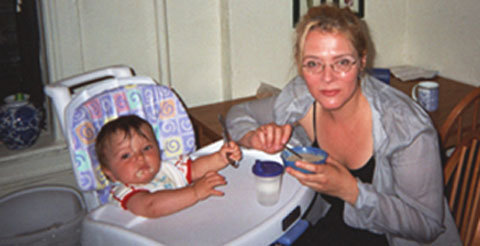
Anne-Marie, Benjamin
Raja Benjamin sits in state on his throne as his dutiful ayah , Anne-Marie Hantho, tries to interest him in swallowing some of that delicious boiled and sweetened Pablum clinging to the edge of a spoon. She is frazzled, he dazzled - or perhaps the other way around- it is early morning for both of them.
To a casual on-looker it might appear that Benjamin is merely trapped between the seat of a high chair and its adjustable table. Yet the imperious manner in which he bangs his spoon, firmly grasped in his left fist like a sceptre, on its creosote surface , leaves no doubt in our minds as to who's the boss , who the subject.
Benjamin cannot yet walk or talk, although he makes intelligible noises. Chubby as a China doll, his glazed, wide, unfocused eyes sparkle like precious stones. He has a jolly smile, never far away from indignation, that leaps forward to his lips between episodes of doubt and suspicion.
Somewhere in the cramped apartment, 6 rooms in a spatular configuration, so confined that the corridor connecting the living-room with the door is permanently blocked with baby carriages and other items, one may find Daddy Jacob wandering about. We overhear him practicing episodes from the Diabelli Variations; or a Bach Partita, or prelude and fugue; or turning on a recording of Sofrinitsky doing Scriabin; or checking for E-mail from numerous accounts he's set up for himself and others.
Operating as the through-line of action for all these activities is the process of dressing for work . He emerges in the kitchen just before leaving, enough time for us to talk briefly about a novel one of us has read, or to recommend somebody 's memoirs, or disparage (or occasionally praise ) the style and reputation of some fashionable concert artist.
"Work" - pre-Benjamin - consisted of studying, playing and teaching piano. "Work" - post-Benjamin - means computer programming and software design for some outfit in uptown Manhattan that Jacob doesn't much enjoy talking about. In this occupation, though he may never have chosen it voluntarily, he has become exceptionally skilled. Another keyboard instrument basically . Once in a long while he arranges to take a piano lesson from his teacher, Marina Jung.
Having learned that I would be traveling to Hungary, Jacob made me a present, two CD's in a box: Le Grand Macabre , opera of Hungarian emigrZŘ composer György Sándor Ligeti . Ligeti ( b. 1923) , less famous than his predecessors and compatriots , Bartok and Kodaly, is nevertheless one of the important European composers of the 20th century. Back in Middletown Le Grand Macabre was absorbed over a two-day interval. It is no more grotesque than it should be: morbid as Stanislaw Witkiewicz , scatological as Alfred Jarry; whimsical as Eric Satie and frivolous as Jacques Offenbach; original as Luciano Berio, and insolite as Michel de Ghelderode, who wrote the libretto .
Then, just before catching the bus that would take me from Middletown to New Haven, I listened for two hours to a recording of Bela Bartok's opera "Bluebeard's Castle" . By the time I boarded the bus, I was trembling like a leaf: what kind of people am I going to find over there ! ??
Jacob lifts up Benjamin to shake him, then places him back in his high chair. He bolts down a cup of ebony-dense coffee and hurries out the door. I return into the living-room, to resume the leisurely chore of packing and re-packing my suitcases for that evening's flight to Amsterdam .